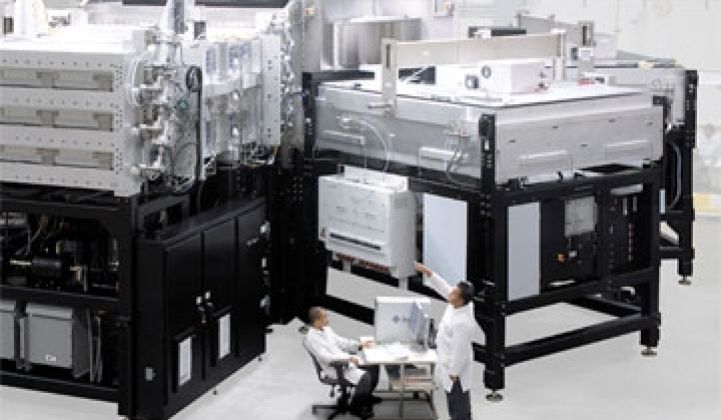The slump in Applied Materials' SunFab solar line continued Wednesday, with sales and orders tumbling in the second quarter and the red ink increasing.
With the business now at perilous levels, Applied Chief Mike Splinter said sharp cuts were on the way, even after an $83 million second-quarter write-down of SunFab equipment the company doesn't think it can sell.
"We are taking decisive steps to redesign the business with a lower outlook," Splinter told analysts on a conference call.
The move will push Applied's entire solar energy business into the red for the year and delay its first profitable quarter until 2011. Applied had hoped for profits by late 2010.
The move is a blow for the beleaguered operations. Applied has maintained that SunFab has a lucrative future making large solar panels for utility-scale solar farms. In early March, we reported on rumors and speculation that Applied Materials might look to scale back or even sell its group that makes equipment for amorphous silicon solar panels. After that, analysts at Goldman Sachs attributed a rise in Applied's stock to news reports that the company might actually scale back on SunFab. Then, at the end of March, Applied indicated it would reduce its investments in SunFab.
In April, Signet Solar, Applied's first customer, pulled plans to build a factory in New Mexico, while another early customer, SunFilm, filed for bankruptcy protection. SunFilm was actually two Applied customers in one: last year, it bought Sontor. Then, more recently, Masdar PV, another large customer, abruptly got rid of its CEO.
Applied claims its panels can reach 10 percent efficiency this year -- an important step in competing with crystalline cells.
Splinter tried to put a positive spin on the setback. He said the company is in business discussions with large utilities in India and China, where large-scale facilities might make more sense.
Applied has accumulated a significant amount of data about production yields and plant efficiencies and knows the formula for success, he said. The key is gigantic fabs, where upfront costs can be spread over a large output.
But success still seems to be more distant. The company admitted the backlog of orders for SunFab equipment fell to $400 million -- roughly two-thirds of what it was a couple quarters ago. On top of that, sales for the entire energy and environmental business fell 54 percent in the recent quarter to $166 million, primarily because of a thin-film shortfall. The operating loss for the division was $145 million, including the inventory write-down.
"Applied sounded more like it is going to wind down or reduce this business," said Neeham & Co. senior analyst Edwin Mok, who listened to the conference call. "They are scaling back."
In contrast, sales of equipment used to make crystalline silicon solar cells boomed in the quarter. Orders reached record heights with manufacturers racing to add capacity, says Chief Financial Officer George Davis. "We're seeing very strong demand, mostly from China."
Unfortunately, the demand is not for thin film.



